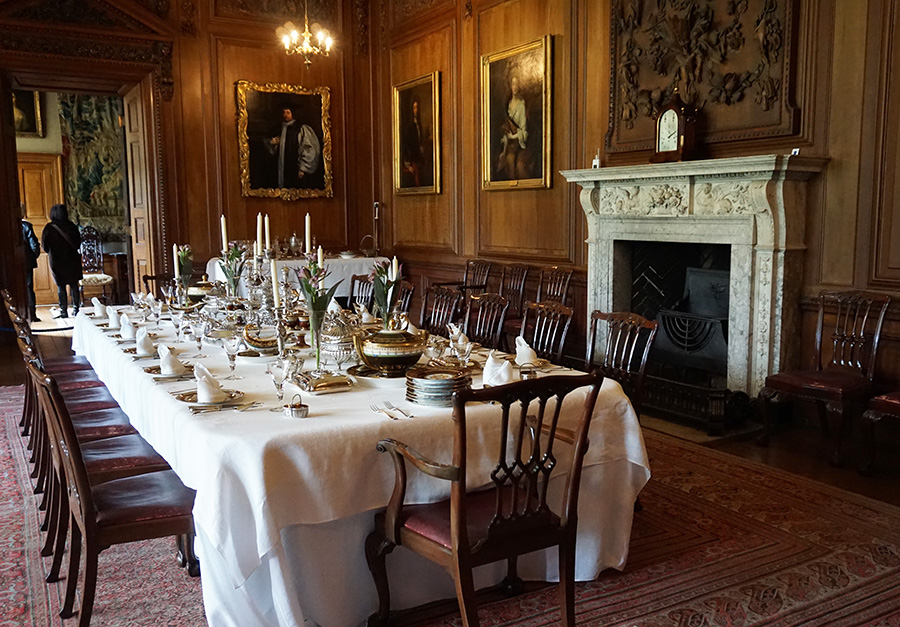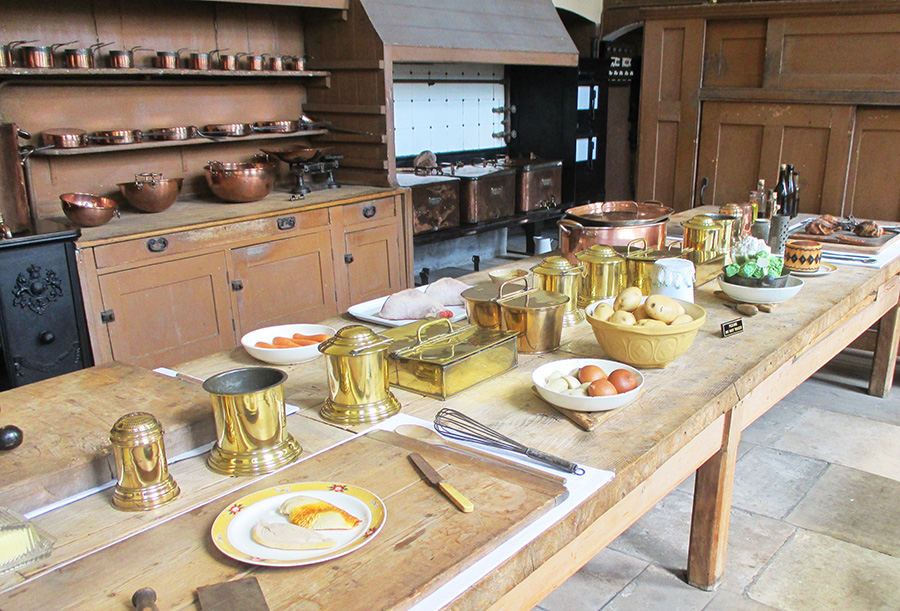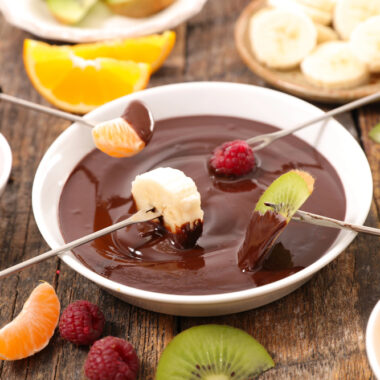Today we’re going to talk about what we can learn from Downton Abbey Times, and from the show itself – things that are significant when it comes to food, dining, and even cooking. We’re excited about the Downton Abbey movie coming up on the 12th of September, so I thought this would be a good time to make this episode.
There are so many things that inspire me when I look at the way they ate and what they ate, although it required having a full-time cook or two. We can’t really replicate that part, but there are a lot of principles that are inspiring, and that we can apply to our daily lives and our families. I did an episode on Downton Abbey before – it was number two – but this will have some new ideas. Some are similar and some are different, but it’s all good stuff, and I’m starting afresh.
Point number one is that meals have a significant role in daily life. In Downton Abbey, you see them ring the dinner gong, and everyone gets dressed smartly for dinner. The tables are set beautifully, the wine is decanted, and everybody spends a lot of time preparing for the meal. It was an important ritual in their daily life. Everybody took time out from everything else. They paused and they prepared; they got dressed smartly, and they were ready for the meal. They were ready to uphold that rhythm in their days.
Then, of course, they would connect with each other at the table. It was a time to slow down, really enjoy each other’s company, and enjoy the food that had been carefully planned. There was Mrs. Hughes making the menus and making sure they had the ingredients, and Mrs. Patmore doing the actual cooking. There were courses of interesting food that they had at the meal. Of course, they were tech-free in those days. There was a candle-lit ambiance, and beautiful flower arrangements on the table.
That’s a lot of things, and I’m going to talk about some of them again, but the point is the whole idea of the meal being part of daily life, an important, significant part. We can apply that by making dinnertime special and significant so that the children know that it’s important. They know that they have to set aside that time, set aside any tech, maybe dress smartly – be wearing shoes, making sure their hair looks good, and that their faces and hands are clean.
The table can be set beautifully. Establish little traditions that your children become accustomed to. Make dinner a good ritual to look forward to. Sometimes you can do it in a way that’s more special than other times, but the important part is that you know that it’s significant, and it’s a time that’s set apart to be together.
Number two – dining is an experience, not just a necessity. It’s not something to just rush through. You shouldn’t quickly eat on the run, or be standing in the kitchen, or watching a show on tv, but it should be a time that’s set aside. Dining is an experience. As I’ve said, in meals at Downton Abbey, they’d have many courses.
We don’t have to have that many, but it is really fun to break up your food into three courses. You can have something for an appetizer. Maybe the vegetables from your main course could be the appetizer instead. Then you can have the meat and maybe a starch, and then you could do a cheese course with some nice baguette or bread like they do in France. After that, you could have a dessert.

The Downton Abbey tables were beautiful. They were set perfectly, measured out by Carson with the crockery and cutlery in perfect positions. There was more than one glass, more than one piece of cutlery for each course, beautifully folded cloth napkins, an elegant centerpiece, and sometimes even printed menus. Any of those small touches really help make it an experience. Then there’s the expectation of dinner being an experience, and there’s attention to detail. You can set your table beautifully. Use a beautiful tablecloth, and you can use some of the things I’ve mentioned. You can use under plates, or anything that helps it to be special.
I mentioned rituals, and another thing that’s fun is a palate cleanser. Have a little bit of lemon sorbet in your freezer, and just put a tiny bit in a little glass or a little bowl for each person in between your first and second courses. That just adds a special touch. Even if we’re not able to do that every night, just come back to the mealtime being a special, significant part of the day – a special ritual, something that everybody looks forward to, a time to connect, leave everything else behind, and reset, and a time to enjoy food and enjoy each other’s company. That’s really so significant.
We need to make sure that we are doing a meal like that multiple times a week, and that we’re coming back to it. If you have an evening out for sports, or something that’s on one evening, and you can’t do this, then return to it the next day. Maybe have three set days a week when you know you’re going to have a special meal.
Maybe you can have one day a week when you do something fun like in my previous episode, ideas for family fun nights. That’s not formal, and it’s not necessarily at the table. It’s just easy food, and a different kind of fun, maybe even in front of a movie. The sort of meal we’re talking about, however, would be at the table together, as often as you can.
Number three – we’ve definitely talked about this one before – is seasonal eating and cooking from scratch using seasonal, local ingredients. In France, they can go to the market every day and choose fresh things. It’s not quite as easy for us with a local supermarket, but we can still try to buy produce that’s in season. It’s often what’s cheapest, most delicious, and most nutrient dense. It’ll look ripe, it’ll look inviting, and it’ll add much more flavor to your meals.
Then there’s cooking things from scratch. In Downton Abbey, they have a cook, of course, and they don’t have much pre-made stuff available from the grocery store; everything was made from scratch. It’s really hard to find time for this in our modern, crazy, hectic world, but there is something amazing, beautiful, and healthy in slowing down when you’re cooking, and having that time before dinner to enjoy cooking.
I don’t get to do this very often, but it’s great if you can find time at least once or twice a week to really slow down and enjoy cooking something a little more elegant. The food doesn’t have to be complicated, but something that’s wholesome, like good meat. You can do a rich meat that’s well prepared and done in the crockpot. You can make some elegant appetizers. Our book, Elegant, Easy Appetizers, gives you a whole lot of ideas for what you can do. There’s stuff that doesn’t even need to be cooked, and is elegant, delicious, and healthy. You can find that at familyfoodformoms.com/shop.
Try to do a little bit of meal planning for your week. Plan things like what meat you’re going to use for each meal, or a substitute like beans or something. Once you know that part, it’s so much easier to plan what’s going to be around that. I find it even easier if you do it in courses. If you know your main course is going to be roast lamb, for the appetizer, you can choose something like cucumber with cream cheese and tomato for the appetizer; something that’s really different from the lamb, and fresh, a light beginning.
Point number four is about afternoon tea. Again, this is much easier if you have a cook in your house, but I think the point of it is to slow down in the afternoon and pause. Pausing is a lost art. Afternoon tea wasn’t just about the food, but about connecting with each other in the middle of the afternoon, and again, slowing down. You’ve done a whole lot of things, and now it’s time to pause, and then you continue.
You can have a family tea time. If you’re homeschoolers, or even if you’re not, you can do a poetry tea time in the afternoon where you all choose a poem to read. You can bake some scones or something small, easy, and fun to have with your tea in the afternoon. It brings the family together in a unique way. Even if dad’s not able to be there, it’s a fun way for mom and the kids to connect, and it’s definitely a good way for mom to slow down and be reminded about that. It’s something I think we need to bring back once a week. Sometimes you can make it elegant. Your children can help you to put out the fancy cups, saucers, and little tea plates. It doesn’t have to be like that every time, though. Sometimes it can just be a plate of eats and a quick cup of tea in a mug, but it does make it extra special to use elegant tea cups and a teapot. That’s fun too. They definitely have beautiful crockery in Downton Abbey.
Number five – we should have kitchen resourcefulness. In Downton Abbey’s kitchen, nothing went to waste. Mrs. Patmore was a master at using leftovers creatively, and I’m sure there were often leftovers because they had to have enough for many people plus visitors. Sometimes there were multiple courses. Perhaps sometimes the downstairs people ate it afterwards, and other times it would be put into something else for the following day. Bones were used for broth. Scraps of various items could be put into something like a quiche. She was very resourceful with leftovers,

It’s not always easy to use leftovers in a way that’s effective. A great way to use up vegetables is in a quiche, and you can use up leftover chicken, gravy, and potatoes by making a chicken pot pie. Otherwise you can create small meals for another day’s lunch, and freeze them so that they stay fresh. Just defrost them on the day you’re going to heat them for lunch. Have some small glass containers with lids to put those meals into. You can have a compost heap. Meals like soups are great as well for using up leftover vegetables or leftover meat scraps.
Number six – the next generation. In Downton Abbey, Daisy was trained up, starting young in the kitchen, and learning from Mrs. Patmore through being mentored. She was intentionally taught the skills that she needed. We can use whatever time we have in the kitchen to involve our kids. Maybe you can do one at a time so that it’s not too overwhelming, but let them help you with small tasks.
They can be given a task to complete – for example, they can wash some potatoes, put them on a baking tray with a bit of oil and salt, and stick them in the oven. They can also just do what you’re doing with you – doing some chopping, doing some mixing, looking at the recipes and learning how things generally work.
Somehow exposure to things in the kitchen, even if you’re not doing them yourself, makes it so much easier to start cooking. For my husband, and many other people who grew up without any idea about cooking, and hardly spending any time in the kitchen, it’s a lot more daunting. It’s not that they can’t do it, it’s just that it feels a lot harder for them. I really believe that having your children in the kitchen with you helps so much.
You can get them to bake some family treats, and you can use those for poetry tea times or for snacks. In our family, some of us don’t eat wheat, so it’s great that we can bake with spelt flour, and have our own treats that are healthier. Get your kids involved, and by the time they’re teenagers, they should be able to make a meal or two on their own. They can also learn during the teenage years. Our teens have learned how to make bolognese, and they’ve learned things like baking chicken in the oven, making lots of side vegetables, potatoes, and how to do soups and stews with some help. Their skills gradually grow with simple things. Of course, there’s times when it’s too much, you’re in a rush, and it’s easier to do it yourself, and that’s completely fine. Give yourself grace, but just try to see who you can involve at each point of your cooking.
Lastly, number seven is celebrations and feasts – using food to mark special occasions; to celebrate. At Downton Abbey, holidays, births, and royal events were celebrated with elaborate meals that had many courses, extra decor, more footmen, and really fancy food. There were things that made it stand out and made it special. It was amazing seeing the movie where the Queen and King came for dinner.
So, special food marks a special moment. It helps to form memories. It helps to make that special time a time of family connection. Celebration food doesn’t have to be fancy, but small touches really help. Like we mentioned in point number one, there’s the way you decorate the table, the way you decorate the room, the candles you use, or other lights like twinkle lights. You can have elegant music playing, and dress up smartly. Make the room look special, and make the food a little special by the way you plate it. We have some episodes on plating food, like in a chef’s menu, and how to make it easy to do at home. Maybe you can print a paper menu for people to follow, or you can have traditional foods on specific holidays.
Just try to celebrate food and celebrate life together. You can add some interesting events like a first day of school dinner, or one for the first day of vacation, and you can have special rituals you do at Easter time and Christmas time with your family. There are also things like the poetry tea time that I mentioned. You can brainstorm a little bit with your kids and ask them which days they find special to celebrate, what kind of things they like to do on those dates, and then plan them in advance.
You can choose some of the national fun days to celebrate. We have two episodes that you can listen to on those, things like National Pancake Day, et cetera, that are to do with food. Those are episodes 46 and 51. Choose the days that you’re going to celebrate together, maybe one each month. We try to have a family meeting once a month on a Sunday evening, and then we plan out the calendar, look at what’s on, and then we plan some fun event type meals that we want to add and celebrate. I hope you get to see the Downton Abbey movie if you’re into it, and that you enjoy it. I can’t wait!





